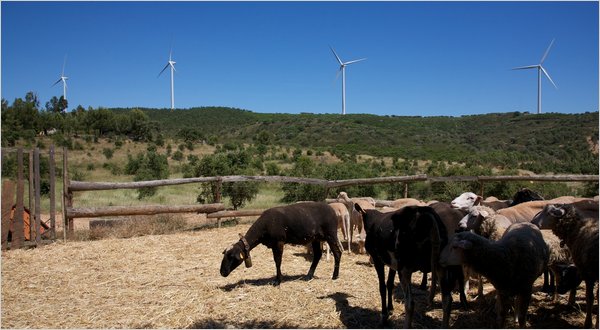
LISBON — Five years ago, the leaders of this sun-scorched, wind-swept nation made a bet: To reduce Portugal’s dependence on imported fossil fuels, they embarked on an array of ambitious renewable energy projects — primarily harnessing the country’s wind and hydropower, but also its sunlight and ocean waves.
Today, Lisbon’s trendy bars, Porto’s factories and the Algarve’s glamorous resorts are powered substantially by clean energy. Nearly 45 percent of the electricity in Portugal’s grid will come from renewable sources this year, up from 17 percent just five years ago.
Land-based wind power — this year deemed “potentially competitive” with fossil fuels by the International Energy Agency in Paris — has expanded sevenfold in that time. And Portugal expects in 2011 to become the first country to inaugurate a national network of charging stations for electric cars.
“I’ve seen all the smiles — you know: It’s a good dream. It can’t compete. It’s too expensive,” said Prime Minister José Sócrates, recalling the way Silvio Berlusconi, the Italian prime minister, mockingly offered to build him an electric Ferrari. Mr. Sócrates added, “The experience of Portugal shows that it is possible to make these changes in a very short time.”
The oil spill in the Gulf of Mexico has renewed questions about the risks and unpredictable costs of America’s unremitting dependence on fossil fuels. President Obama has seized on the opportunity to promote his goal of having 20 to 25 percent of America’s electricity produced from renewable sources by 2025.
While Portugal’s experience shows that rapid progress is achievable, it also highlights the price of such a transition. Portuguese households have long paid about twice what Americans pay for electricity, and prices have risen 15 percent in the last five years, probably partly because of the renewable energy program, the International Energy Agency says.
Although a 2009 report by the agency called Portugal’s renewable energy transition a “remarkable success,” it added, “It is not fully clear that their costs, both financial and economic, as well as their impact on final consumer energy prices, are well understood and appreciated.”
Indeed, complaints about rising electricity rates are a mainstay of pensioners’ gossip here. Mr. Sócrates, who after a landslide victory in 2005 pushed through the major elements of the energy makeover over the objections of the country’s fossil fuel industry, survived last year’s election only as the leader of a weak coalition.
“You cannot imagine the pressure we suffered that first year,” said Manuel Pinho, Portugal’s minister of economy and innovation from 2005 until last year, who largely masterminded the transition, adding, “Politicians must take tough decisions.”
Still, aggressive national policies to accelerate renewable energy use are succeeding in Portugal and some other countries, according to a recent report by IHS Emerging Energy Research of Cambridge, Mass., a leading energy consulting firm. By 2025, the report projected, Ireland, Denmark and Britain will also get 40 percent or more of their electricity from renewable sources; if power from large-scale hydroelectric dams, an older type of renewable energy, is included, countries like Canada and Brazil join the list.
The United States, which last year generated less than 5 percent of its power from newer forms of renewable energy, will lag behind at 16 percent (or just over 20 percent, including hydroelectric power), according to IHS.
To force Portugal’s energy transition, Mr. Sócrates’s government restructured and privatized former state energy utilities to create a grid better suited to renewable power sources. To lure private companies into Portugal’s new market, the government gave them contracts locking in a stable price for 15 years — a subsidy that varied by technology and was initially high but decreased with each new contract round.
Compared with the United States, European countries have powerful incentives to pursue renewable energy. Many, like Portugal, have little fossil fuel of their own, and the European Union’s emissions trading system discourages fossil fuel use by requiring industry to essentially pay for excessive carbon dioxide emissions.
Portugal was well poised to be a guinea pig because it has large untapped resources of wind and river power, the two most cost-effective renewable sources. Government officials say the energy transformation required no increase in taxes or public debt, precisely because the new sources of electricity, which require no fuel and produce no emissions, replaced electricity previously produced by buying and burning imported natural gas, coal and oil. By 2014 the renewable energy program will allow Portugal to fully close at least two conventional power plants and reduce the operation of others.
“So far the program has placed no stress on the national budget” and has not created government debt, said Shinji Fujino, head of the International Energy Agency’s country study division.
If the United States is to catch up to countries like Portugal, energy experts say, it must overcome obstacles like a fragmented, outdated energy grid poorly suited to renewable energy; a historic reliance on plentiful and cheap supplies of fossil fuels, especially coal; powerful oil and coal industries that often oppose incentives for renewable development; and energy policy that is heavily influenced by individual states.
The relative costs of an energy transition would inevitably be higher in the United States than in Portugal. But as the expense of renewable power drops, an increasing number of countries see such a shift as worthwhile, said Alex Klein, research director, clean and renewable power generation, at IHS.
“The cost gap will close in the next decade, but what you get right away is an energy supply that is domestically controlled and safer,” Mr. Klein said.



